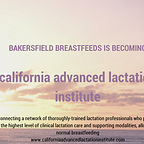Addressing Breastfeeding Ambivalence
The First 100 Hours©
Addressing Breastfeeding Ambivalence
The First 100 Hours© is a strategy designed with flexibility to encompass even mothers in whom ambivalence or low level of commitment to breastfeeding has been observed. Mothers with low levels of understanding regarding the importance of human milk are more likely to feed formula in the hospital and in the early postpartum period overall, to supplement breastfeeding with formula even after copious milk production has begun, and to wean earlier than mothers who prenatally state an intention to exclusively breastfeed. This strategy has the potential to influence this population of less motivated mothers and to increase rates of exclusive breastfeeding in the hospital, to reduce the number of babies receiving formula while in a NICU or special care nursery, and to increase the duration of any breastfeeding. These are valuable outcomes for the health of mothers and babies, for clinical care providers who struggle to support mothers’ breastfeeding intentions, and for hospitals and birth facilities looking to improve their breastfeeding rates.
Expectant mothers have widely ranging reasons for being ambivalent, neutral, or wary of breastfeeding. Education has historically been the tool of choice to overcome this particular situation. Adult learners require active, kinesthetic learning modalities. What is more kinesthetic than simply supporting their once-in-a-lifetime opportunity to provide their baby with 100 hours of breastfeeding and/or breastmilk?
A mother who has not been informed of the risks of formula feeding or the importance of feeding breastmilk in the first days of life in particular requires thorough education. The message that formula has no health benefits is largely missing from the cultural breastfeeding discussion, and some mothers misinterpret formula marketing messages to mean that formula is actually better than or the same as breastmilk. The First 100 Hours© Strategy proposes to shift attitudes and motivation on the individual as well as the cultural level.
In combination with verbal education, a mother should be experiencing breastfeeding. Assisting a mother with breastfeeding and providing appropriate verbal instructions and encouragement to continue breastfeeding for The First 100 Hours© of life is the most basic and fundamental part of this strategy. A target of 100 Hours of breastfeeding is much easier to envision accomplishing than the “6 months of exclusive breastfeeding” which is recommended by health organizations. Upon reaching 100 Hours, she will then have options: a) continue exclusively breastfeeding for 6 months with an optimally stimulated and protected milk supply, b) discontinue feeding at the breast but initiate pumping to ensure her baby receives only breastmilk for the first 6 months of life, or c) elect to wean completely from breastmilk, having provided her infant the ideal nutrition for the first 4 days of life, including an unparalleled immune system boost, while also improving her recovery process.
For the mother who expresses a deep desire to avoid feeding at the breast, that preference should always be respected and honored. However, she should be provided with appropriate education regarding the importance of a non-breastfed baby receiving breastmilk as its only nutrition.
In cases where a mother states she “only wants to pump and bottlefeed,” education and assistance are crucial to her potential for successfully meeting that goal. Pumping is vitally important, yet largely ineffective at yielding significant amounts of milk during The First 100 Hours©. A mother who plans to exclusively pump milk for her infant for any length of time should be taught hand expression from the time of birth so that she, like the breastfeeding mother, can honor her infant’s feeding cues by expressing milk when she notes hunger cues. She should also be provided education and assistance with using a high-quality breastpump (if available) as soon as volumes of expressed milk begin to increase, or earlier if preferred. A non-breastfeeding mother should still maintain continuous skin to skin contact with her infant, expressing milk into a spoon with baby still on her chest and feeding immediately.
Similar to the widespread promotion of immediate skin to skin contact between newborns and mothers directly after birth, The First 100 Hours© Strategy can reasonably be expected to have positive results on the overall health and well-being of mothers and babies and to have the side effect of increasing the number of mothers initiating and continuing to breastfeed, which benefits everyone.
Christine Staricka, BS, RLC, IBCLC, CCE
June 2014
